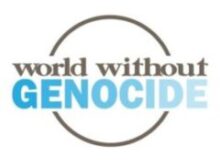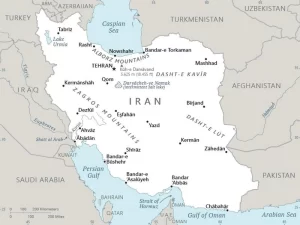Iran
A theocratic Shi’a Muslim regime has controlled Iran’s government since the 1979 Iranian Revolution. Opposition to the regime is not permitted; Iran arrests political dissidents, detains and prosecutes them without due process, and conducts summary executions. Women lack equal rights to men and must conform to restrictive dress codes or face imprisonment. Iran labels LGBTQ+ individuals as deviants, bars their public presence, and administers the death penalty for “homosexual” activity. Ethnic minorities face systemic discrimination in healthcare, education, and politics. Religious minorities, particularly the Baha’i, are persecuted by the state, and they are denied equal citizenship, freedom of worship, and the right to convert from Islam to another faith.
Iran engages in proxy conflicts across the Middle East, leading to widespread accusations of human rights abuses carried out by its militant groups and a fear of wider regional war.
Where
Iran has a population of over 88 million people and borders Armenia, Azerbaijan, and Turkmenistan to the north, Turkey to the northwest, Iraq to the west, and Afghanistan and Pakistan to the east. [1] Persians comprise the largest ethnic group, followed by minority populations including Kurds, Baloch, Azeris, Turkmen, Ahwazi Arabs, and Lurs. [2] While most of the nation practices Shi’a Islam, Iran hosts significant numbers of Sunni Muslims, Christians, Zoroastrians, Jews, Bahá’í, Yarsanis, and other religious minorities. [3] A clerical Supreme Leader rules Iran, holding total authority over its armed forces and supervising the elected government and judiciary. [4]
What
Political Repression
In 1925, the Pahlavi royal dynasty took control of Iran’s government through a constitutional monarchy. They suppressed dissent via secret police, torture, mass imprisonment, and the execution of hundreds of political prisoners. [5] In 1953, the Iranian army overthrew Prime Minister Mohammad Mosaddegh in a British- and American-backed coup. [6] Autocratic rule continued until 1979, when the Iranian Revolution established the Islamic Republic of Iran. [7]
The Islamic Republic, led by Ayatollah Khomeini, banned political opposition, restricted media, and incarcerated tens of thousands of dissenters, including children and individuals linked to the former government. [8] It also killed tens of thousands of these prisoners across the next decade. [9] Two major periods defined these killings. From 1981 to 1982, the state executed up to 4,400 civilians detained on arbitrary “charges of moharebeh (‘waging war against God’) and efsad-e fel-arz (‘spreading corruption on Earth’).” [10] Massacres continued for years afterward. [11] Then in 1988, Ayatollah Khomeini issued a fatwa that formed ad hoc “Death Commissions” to liquidate political prisoners connected to the People’s Mujahedin of Iran (MEK)—an armed dissident group—and other leftist organizations. [12] The tribunals executed up to 30,000 people. [13] Iran refused to issue or falsified death certificates for those killed, buried victims in unmarked mass graves, and hindered international investigations into its abuses. [14] Many alleged perpetrators retain political power today. [15] In 2024, the United Nations Special Rapporteur on Iran labeled these actions crimes against humanity, atrocity crimes, and genocide. [16]
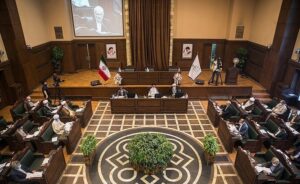
Iranian Supreme Court: The legal system in Iran denies prisoners due process and applies vague legal standards to sentencing. Image courtesy of Tasnim News Agency is unmodified and licensed under CC BY 4.0.
Political suppression in this vein continues within Iran. The state censors all press and arrests individuals who oppose it under vague political crime laws, subjecting them to the death penalty. [17] Defendants lack due process protection, with judges denying them attorney access, admitting evidence obtained through torture at trial, and determining verdicts in advance. [18] Prisoners endure physical and mental assault from guards, alongside unhygienic and abusive prison conditions. [19] Iran also targets dual nationals for imprisonment, sometimes kidnapping them abroad before using them as hostages or executing them. [20] Iran carries out the highest number of executions in the world after China, and from January 2024 to November 2024, about 800 individuals were killed, including anti-regime dissidents. [21] For almost a year, inmates across 27 prisons in Iran have staged hunger strikes to protest these executions as part of the “No to Execution Tuesdays” campaign. [22
Gender Oppression
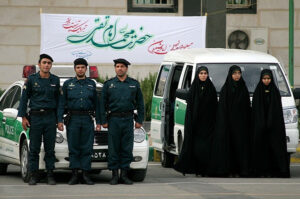
Iran’s Morality Police, or Guidance Patrol, enforces strict regulations on modest dress for women. Image courtesy of Fars Media Corporation is unmodified and licensed under CC BY 4.0.
Iranian women experience systematic discrimination. Laws relating to family, divorce, inheritance, and child custody privilege men. [23] Iran does not ban marital rape or domestic violence, and femicide is widespread. [24] Girls as young as nine are legally married. [25] Women are underrepresented at all government levels, the state limits what jobs women can hold, and sex segregation permeates public services. [26] Schools emphasize female subjugation to men. [27] Iran heavily polices women’s clothing and requires women to fully cover their hair and bodies in public. [28] Dissenters face fines, imprisonment, and flogging. [29] In 2022, the morality police beat 22-year-old Mahsa Amini to death for violating veiling laws. [30] Mass protests followed, calling for regime change under the slogan “Woman, Life, Freedom.” [31] In response, Iran shut down the internet, killed protesters, and detained tens of thousands of people. [32] Iran fortified its modesty laws via a 2023 “Hijab and Chastity” Bill that increased penalties for violating covering laws, increased prison sentences for offenders, and expanded police enforcement powers. [33]
This discrimination extends to the LGBTQ+ community. Iran demonizes gay Iranians as threats to public security, authorities force LGBTQ+ individuals into conversion therapy, and homosexuality is considered a capital offense. [34] Iran allows sex-reassignment surgery and recognizes sex changes, but transgender people still endure extensive prejudice and violence. [35] Because of this more relaxed governmental stance toward transgender identity, gay men and women encounter immense pressure to transition to gain wider societal acceptance, as doing so would render their same-sex attraction opposite-sex to the state. [36]
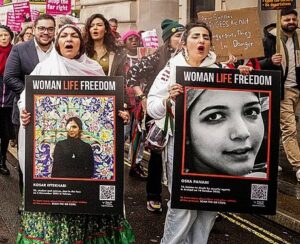
Woman, Life, Freedom protests began in Iran and continued across the world. Image courtesy of alisdare1 is cropped and licensed under CC BY-SA 2.0.
Ethnic Minority Oppression
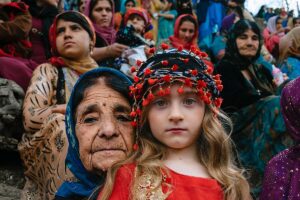
A Kurdish woman and grandchild in traditional dress, Besaran Village, Kurdistan, Iran. Image courtesy of Salar Arkan – سالار ارکان is cropped and licensed under CC BY-SA 4.0.
Ethnic minorities in Iran encounter extensive discrimination in education, employment, housing, political representation, and more. [37]:
- The government confiscates land and water resources from Turkmen and Ahwazi Arabs. [38]
- The state arrests Kurdish autonomy advocates and attacks Kurds traveling to visit Kurdistan in Iraq. [39]
- Azeris face police harassment and restrictions in giving traditional names to their children. [40]
Iran disproportionately executes members of minority ethnic groups. [41] High poverty rates affect them excessively. [42]
Iran houses 5 million Afghans, including 3 million documented and undocumented refugees. [43] Others come as migrant workers and endure employer abuse. [44] The government keeps refugees in unsanitary camps and limits their education and work access. [45] Iran recently began deporting Afghan asylum seekers back to Afghanistan en masse despite increasing human rights abuses there. [46] This violates the 1951 Refugee Convention, to which Iran is a signatory. [47]
Religious Oppression
Iran’s constitution names Shi’a Islam as its state religion, which enables persecution of religious minorities. [48] The government recognizes five non-Muslim religious groups—Armenian Christians, Assyrian Christians, Chaldean Christians, Jews, and Zoroastrians—and reserves 5 out of 290 parliamentary seats for them (1.7%). [49] Other non-Muslim faiths receive no political representation. [50]
Iranian officials label religious minorities impure and target them through state-sponsored media. [51] Iran arrests Sunni clergy for criticism of government policies, prosecutes Christians for practicing their religion at home, and encourages schoolchildren to spy on Jewish classmates. [52] The law labels conversion away from Islam as apostasy and considers public expressions of atheism as blasphemy, with those convicted of either charge facing death. [53]
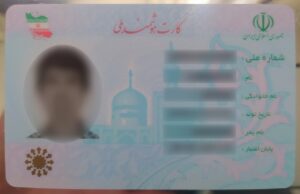
Iranian national identity card. Image courtesy of Samanmer2002 is unmodified and licensed under CC BY-SA 4.0.
Observers estimate that 85% of human rights abuses against religious groups in Iran target Baha’is. [54] Police consistently arrest Baha’is for practicing their faith. [55] They shut down Baha’i businesses and transfer their property to the state. [56] Iran prevents Baha’is from carrying out burial rites, desecrates Baha’i cemeteries, and denies them access to holy sites. [57] It outlaws Baha’i employment in multiple fields and bars them from state benefits programs. [58] Public universities refuse Baha’i admission and Iran excludes Baha’is, and other unrecognized religious minorities, from obtaining national identity cards, putting them at risk of statelessness. [59]
How
The Iranian government uses parts of its armed forces, like the Islamic Revolutionary Guard Corps (IRGC), citizen-orientated brigades, and mass surveillance methods to restrict dissent. [60]
Iran supports various proxy groups across the Middle East to limit Saudi Arabian regional dominance and U.S. and Israeli influence. [61] These include the Houthis in Yemen, Hamas in Palestine, Hezbollah in Lebanon, various militias in Iraq, and the (former) Assad government in Syria. [62] It also supplies Russia with arms for the war in Ukraine. [63] Iran recruits child soldiers from marginalized groups to fight in its funded conflicts. [64]
Iran has engaged in a decades-long proxy war against Israel. [65] A major contention point between the two is Iran’s nuclear program, which threatens to destabilize the Middle East. [66] Iran reached an agreement in 2015 with global powers, including the US, to limit its nuclear abilities. The US and Iran have since exited the deal. [67]
Response
The United States, European Union, Canada, and other nations impose targeted economic sanctions on Iran and its leaders. [68] The US designates Iran a state sponsor of terror. [69] In 2022, the UN Human Rights Council created an Independent International Fact-Finding Mission on the Islamic Republic of Iran. [70] The Special Rapporteur for Iran, whose mandate was renewed with that of the Fact-Finding Mission and runs through April 2025, has issued multiple reports detailing human rights abuses committed by the state. [71]
International and domestic organizations advocate for regime change through protests, education, legal aid, and other strategies, often encountering substantial reprisals from the government. They also work to hold Iran accountable for its past abuses; Justice for the Victims of the 1988 Massacre in Iran (JVMI), for example, hosted a civil society hearing, conference, and advocacy campaign in 2024 that provided evidence for and publicized the Special Rapporteur’s report on the 1988 killings. [72]
Future
Iran held elections in 2024 following the death of President Ebrahim Raisi. Masoud Pezeshkian, labeled a “reformist” candidate, won the election. [73] Most observers doubt his ability to enact meaningful change. [74] Protests against Iran’s government continue. Thousands of dissidents remain imprisoned. [75] Human rights abuses persist as dissent increases.
This page was written by Bekir Hodzic, November 2024.
References
[1] Central Intelligence Agency. (2024, November 19). Iran. The World Factbook. https://www.cia.gov/the-world-factbook/countries/iran/
[2] Central Intelligence Agency. (2024, November 19). Iran. The World Factbook. https://www.cia.gov/the-world-factbook/countries/iran/
[3] 2023 Report on International Religious Freedom: Iran. (n.d.). U.S. Department of State. https://www.state.gov/reports/2023-report-on-international-religious-freedom/iran/
[4] CFR.org Editors. (2024, June 25). The Islamic Republic’s Power Centers. Council on Foreign Relations. https://www.cfr.org/article/islamic-republics-power-centers
[5] Cottam, R. W. (Winter 1980). Human Rights in Iran Under the Shah. Case Western Reserve Journal of International Law, 12(1), 121-136. https://scholarlycommons.law.case.edu/cgi/viewcontent.cgi?article=1913&context=jil
[6] Karimi, N. & Gambrell, J. (2023, August 25). A CIA-backed 1953 coup in Iran haunts the country with people still trying to make sense of it. AP News. https://apnews.com/article/iran-1953-coup-us-tensions-3d391c0255308a7c13d32d3c88e5f54f
[7] Cottam, R. W. (Winter 1980). Human Rights in Iran Under the Shah. Case Western Reserve Journal of International Law, 12(1), 121-136. https://scholarlycommons.law.case.edu/cgi/viewcontent.cgi?article=1913&context=jil
[8] Iran Closes a Leading Paper in Crackdown on the Press. (1979, August 8). The New York Times. https://www.nytimes.com/1979/08/08/archives/iran-closes-a-leading-paper-in-crackdown-on-the-press-statement.html; Priborkin, E. (2019, April 8). 40 Years Later: Iran after the Islamic Revolution. American University. https://www.american.edu/sis/news/20190408-40-years-later-iran-after-the-islamic-revolution.cfm
[9] Nasiri, S., & Azar, L. F. (2022). Investigating the 1981 Massacre in Iran: On the Law-Constituting Force of Violence. Journal of Genocide Research, 26(2), 164–187. https://doi.org/10.1080/14623528.2022.2105027
[10] Rehman, J. (2024, July 17). “Atrocity Crimes” and grave violations of human rights committed by the Islamic Republic of Iran (1981–1982 and 1988. United Nations Office of the High Commissioner for Human Rights. https://www.ohchr.org/sites/default/files/documents/countries/iran/20240717-SR-Iran-Findings.pdf
[11] Rehman, J. (2024, July 17). “Atrocity Crimes” and grave violations of human rights committed by the Islamic Republic of Iran (1981–1982 and 1988. United Nations Office of the High Commissioner for Human Rights. https://www.ohchr.org/sites/default/files/documents/countries/iran/20240717-SR-Iran-Findings.pdf
[12] Rehman, J. (2024, July 17). “Atrocity Crimes” and grave violations of human rights committed by the Islamic Republic of Iran (1981–1982 and 1988. United Nations Office of the High Commissioner for Human Rights. https://www.ohchr.org/sites/default/files/documents/countries/iran/20240717-SR-Iran-Findings.pdf; Blood-soaked secrets: Why Iran’s 1988 prison massacres are ongoing crimes against humanity. (2018, December 4). Amnesty International. https://www.amnesty.org/en/documents/mde13/9421/2018/en/
[13] Shahrooz, K. (2007). With Revolutionary Rage and Rancor: A Preliminary Report on the 1988 Massacre of Iran’s Political Prisoners. Harvard Human Rights Journal 20(1), 227-261. https://journals.law.harvard.edu/hrj/wp-content/uploads/sites/83/2020/06/20HHRJ227-Shahrooz.pdf
[14] Rehman, J. (2024, July 17). “Atrocity Crimes” and grave violations of human rights committed by the Islamic Republic of Iran, 1981–1982 and 1988. United Nations Office of the High Commissioner for Human Rights. https://www.ohchr.org/sites/default/files/documents/countries/iran/20240717-SR-Iran-Findings.pdf; Iran’s 1988 Mass Executions: Evidence & Legal Analysis of “Crimes Against Humanity.” (2022, June 8). Human Rights Watch. https://www.hrw.org/news/2022/06/08/irans-1988-mass-executions
[15] Iran: UN calls for accountability on 1988 prison massacres marks turning point in three-decade struggle. (2020, December 9). Amnesty International. https://www.amnesty.org/en/latest/press-release/2020/12/iran-un-calls-for-accountability-on-1988-prison-massacres-marks-turning-point-in-three-decade-struggle/
[16] Rehman, J. (2024, July 17). “Atrocity Crimes” and grave violations of human rights committed by the Islamic Republic of Iran, 1981–1982 and 1988. United Nations Office of the High Commissioner for Human Rights. https://www.ohchr.org/sites/default/files/documents/countries/iran/20240717-SR-Iran-Findings.pdf
[17] 2023 Country Reports on Human Rights Practices: Iran. (n.d.). U.S. Department of State. https://www.state.gov/reports/2023-country-reports-on-human-rights-practices/iran/; Iran. (n.d.). Reporters Without Borders. Accessed November 25, 2024, from https://rsf.org/en/country/iran; Iran: the persecution of journalists continues despite new president’s promise. (2024, September 6). Reporters Without Borders. https://rsf.org/en/iran-persecution-journalists-continues-despite-new-president-s-promise; Iran: Chokehold on Dissent. (2024, January 11). Amnesty International. https://www.hrw.org/news/2024/01/11/iran-chokehold-dissent; Kaviani, H. & Ghazi, F. (2023, August 30). ‘Era Of Repression’: Iran Purges Ranks of University Professors Ahead Of Protest Anniversary. Radio Free Europe/Radio Liberty. https://www.rferl.org/a/iran-amini-anniversary-professors-purge/32571418.html; Iran OKs 6 candidates for presidential race, but again blocks Ahmadinejad. (2024, June 9). AP News. https://apnews.com/article/iran-election-raisi-ahmadinejad-557dd8e41a9abf78e0ad02e0e21d4e00
[18] Danesh, T. & Amiry-Moghaddam, M., eds. (2017). Iran Human Rights Review: Due Process. The Foreign Policy Centre. https://fpc.org.uk/wp-content/uploads/2017/02/IHRR-Due-Process.pdf; Morello, C. (2015, May 29). Verdicts often set before trials take place in Iran’s revolutionary courts. The Washington Post. https://www.washingtonpost.com/world/national-security/irans-revolutionary-courts-are-criticized-as-swift-and-unjust/2015/05/29/2d203708-0555-11e5-8bda-c7b4e9a8f7ac_story.html; Iran 2023. (n.d.). Amnesty International. https://www.amnesty.org/en/location/middle-east-and-north-africa/middle-east/iran/report-iran/; Danesh, T. & Amiry-Moghaddam, M., eds. (2017). Iran Human Rights Review: Due Process. The Foreign Policy Centre. https://fpc.org.uk/wp-content/uploads/2017/02/IHRR-Due-Process.pdf
[19] Gholami, N. (2022, October 20). A look inside Iran’s notorious Evin prison. DW. https://www.dw.com/en/irans-evin-prison-experience-was-psychological-torture-says-former-prisoner/a-63509722; Goudarzi, N. (2024, June 17). Evin Prison’s Ward 4: Cramped, Filthy, Pest-Ridden, and Ignored. Iran International. https://www.iranintl.com/en/202406157248; Iranian Prisons Are Places Of Relentless Suffering. (2024, June 4). Spreading Justice. https://spreadingjustice.org/iranian-prisons-are-places-of-relentless-suffering/; 2023 Country Reports on Human Rights Practices: Iran. (n.d.). U.S. Department of State. https://www.state.gov/reports/2023-country-reports-on-human-rights-practices/iran/
[20] Loft, P. (2023, September 1). Dual nationals imprisoned in Iran. UK Parliament. https://commonslibrary.parliament.uk/research-briefings/cbp-8147/; Brown, B. & Alkhshali, H. (2024, October 29). German-Iranian national and longtime US resident executed in Iran. CNN. https://www.cnn.com/2024/10/28/middleeast/jamshid-sharmahd-iran-executed-intl/index.html
[21] Executions Around the World. (n.d.). Death Penalty Information Center. Accessed November 25, 2024, from https://deathpenaltyinfo.org/policy-issues/international/executions-around-the-world; Motazedi, N. (2024, December 4). Worldwide Monthly Roundup: China, Iran, Saudi Arabia, Singapore, and Vietnam. Death Penalty Information Center. https://deathpenaltyinfo.org/worldwide-international-monthly-roundup-china-iran-saudi-arabia-singapore-and-vietnam
[22] VOA Persian. (2024, December 17). VOA Persian: Iran executed at least 40 people in one week, group says. Voices of America. https://www.voanews.com/a/7904832.html; World Coalition Against the Death Penalty. (2024, August 28). In support and solidarity with “No Death Penalty Tuesdays” abolitionist movement in Iran. World Coalition Against the Death Penalty. https://worldcoalition.org/2024/08/28/statement-iran-august-2024/
[23] 2023 Country Reports on Human Rights Practices: Iran. (n.d.). U.S. Department of State. https://www.state.gov/reports/2023-country-reports-on-human-rights-practices/iran/; Married Women in Iran Still Need “Permission” to Travel Abroad Under Amendment to Passport Law. (2017, July 18). Center for Human Rights in Iran. https://iranhumanrights.org/2017/07/married-women-in-iran-still-need-permission-to-travel-abroad-under-amendment-to-passport-law/; Gholamhosseinpour, M. (2019, November 2). Permission to Travel — A Nightmare for Many Iranian Women. IranWire. https://iranwire.com/en/features/66384/; Reuters. (2023, October 6). How Iran treats women. Reuters. https://www.reuters.com/world/middle-east/how-iran-treats-women-2023-10-06/
[24] Iran: Adopt Draft Law to Protect Women. (2020, December 4). Human Rights Watch. https://www.hrw.org/news/2020/12/04/iran-adopt-draft-law-protect-women; Iran: Events of 2023. (n.d.). Human Rights Watch. https://www.hrw.org/world-report/2024/country-chapters/iran; Iran International Newsroom. (2024, May 12). Killings of Women Surge in Iran: 23 Killed by Male Relatives. Iran International. https://www.iranintl.com/en/202405123691
[25] New Research Shows Rise In Child Marriages In Iran. (2023, December 24). Iran International. https://www.iranintl.com/en/202312241642; Iran: Women and girls treated as second class citizens, reforms urgently needed, says UN expert. (2021, March 8). United Nations Office of the High Commissioner for Human Rights. https://www.ohchr.org/en/press-releases/2021/03/iran-women-and-girls-treated-second-class-citizens-reforms-urgently-needed; Atrocities Suffered by Iran’s Minority Children Are Largely Ignored by World. (2024, November 20). Center for Human Rights in Iran. https://iranhumanrights.org/2024/11/atrocities-suffered-by-irans-minority-children-are-largely-ignored-by-world/
[26] Iran (Islamic Republic of). (n.d.). UN Women. Accessed November 25, 2024, from https://data.unwomen.org/country/iran-islamic-republic-of; Zimmt, R. (2020, October 15). Will Iran let a woman run for president in 2021? Atlantic Council. https://www.atlanticcouncil.org/blogs/iransource/will-iran-let-a-woman-run-for-president-in-2021/; Gholamhosseinpour, M. (2020, October 8). Why is Iran’s Judiciary a Male-Dominated Institution? IranWire. https://iranwire.com/en/features/67752/; “It’s a Men’s Club”: Discrimination Against Women in Iran’s Job Market. (2017, May 25). Human Rights Watch. https://www.hrw.org/report/2017/05/26/its-mens-club/discrimination-against-women-irans-job-market; Shahrokni, N. (2020). Women in Place: The Politics of Gender Segregation in Iran. University of California Press. https://www.jstor.org/stable/j.ctvqr1brb
[27] Moinipour, S. (2022, April 4). Iran’s Educational System and the Institutionalization of Gender Inequality. Georgetown Journal of International Affairs. https://gjia.georgetown.edu/2022/04/04/irans-educational-system-and-the-institutionalization-of-gender-inequality/
[28] Far, T. S. (2023, June 26). Unveiling Resistance: The Struggle for Women’s Rights in Iran. Human Rights Watch. https://www.hrw.org/news/2023/06/26/unveiling-resistance-struggle-womens-rights-iran; 2023 Country Reports on Human Rights Practices: Iran. (n.d.). U.S. Department of State. https://www.state.gov/reports/2023-country-reports-on-human-rights-practices/iran/
[29] Far, T. S. (2023, June 26). Unveiling Resistance: The Struggle for Women’s Rights in Iran. Human Rights Watch. https://www.hrw.org/news/2023/06/26/unveiling-resistance-struggle-womens-rights-iran
[30] Loft, P. (2023, May 26). 2022 Iran protests: Human rights and international response. UK Parliament. https://commonslibrary.parliament.uk/research-briefings/cbp-9679/; Iran: A really simple guide to the protests. (2023, September 15). BBC. https://www.bbc.com/news/world-middle-east-63240911
[31] Abadi, C. (2022, December 25). Iran’s Revolutionary Year. Foreign Policy. https://foreignpolicy.com/2022/12/25/iran-protest-revolution-2022-raisi-irgc/; Iran: A really simple guide to the protests. (2023, September 15). BBC. https://www.bbc.com/news/world-middle-east-63240911
[32] Cumming-Bruce, N. (2024, March 8). Iran’s 2022 Protest Crackdown Included Killings, Torture and Rape, U.N. Finds. The New York Times. https://www.nytimes.com/2024/03/08/world/middleeast/iran-protest-mahsa-amini-un-report.html; Strzyżyńska, W. (2022, September 22). Iran blocks capital’s internet access as Amini protests grow. The Guardian. https://www.theguardian.com/world/2022/sep/22/iran-blocks-capitals-internet-access-as-amini-protests-grow
[33] Iran: New Hijab Law Adds Restrictions and Punishments. (2024, October 14). Human Rights Watch. https://www.hrw.org/news/2024/10/14/iran-new-hijab-law-adds-restrictions-and-punishments; Iran’s proposed hijab law could amount to “gender apartheid”: UN experts. (2023, September 1). United Nations Office of the High Commissioner for Human Rights. https://www.ohchr.org/en/press-releases/2023/09/irans-proposed-hijab-law-could-amount-gender-apartheid-un-experts
[34] The Associated Press. (2022, February 2). Iran executes 2 gay men over sodomy charges, rights group says. NBC News. https://www.nbcnews.com/nbc-out/out-news/iran-executes-2-gay-men-sodomy-charges-rights-group-says-rcna14540; Goldoust, S. (2021, February 18). LGBT Iranians Recount the Horrors of “Conversion Therapy”. IranWire. https://iranwire.com/en/features/68980/; 2023 Country Reports on Human Rights Practices: Iran. (n.d.). U.S. Department of State. https://www.state.gov/reports/2023-country-reports-on-human-rights-practices/iran/; LGBT Rights in Iran. (n.d.). EqualDex. Accessed November 25, 2024, from https://www.equaldex.com/region/iran
[35] Ghaedi, M. (2021, May 16). How transgender people navigate Iran. DW. https://www.dw.com/en/iran-how-transgender-people-survive-ultraconservative-rule/a-57480850
[36] Hamedani, A. (2014, November 5). The gay people pushed to change their gender. BBC. https://www.bbc.com/news/magazine-29832690
[37] Protests, discrimination and the future of minorities in Iran. (2022, November 24). Minority Rights Group. https://minorityrights.org/resources/protests-discrimination-and-the-future-of-minorities-in-iran/; Shaffer, B. (2022, October 19). How Iran’s Ethnic Divisions Are Fueling the Revolt. Foreign Policy. https://foreignpolicy.com/2022/10/19/iran-protests-persians-minorities-ethnic-language-discrimination-regime-separatism/; Aman, F. (2023, February 27). Protests Have Brought Iran’s Ethnic Minorities & Persian Majority Closer. Stimson Center. https://www.stimson.org/2023/protests-have-brought-irans-ethnic-minorities-persian-majority-closer/
[38] Alabbasi, M. (2015, February 28). Iran’s Ahwazi Arab minority: dissent against ‘discrimination’. Middle East Eye. https://www.middleeasteye.net/news/irans-ahwazi-arab-minority-dissent-against-discrimination; Annayev, D. (2020, July 23). Radio programme reveals extent of Turkmen oppression by Iranian regime. Caravanserai. https://central.asia-news.com/en_GB/articles/cnmi_ca/features/2020/07/23/feature-01; Hamid, R. (2021, December 6). Iran’s Ethnic Minorities Face Double Discrimination. Fair Observer. https://www.fairobserver.com/region/middle_east_north_africa/rahim-hamid-ahwazi-arabs-ethnic-minorities-human-rights-iran-news-11112/; Iran’s Khuzestan: Thirst and Turmoil. (2023, August 21). International Crisis Group. https://www.crisisgroup.org/middle-east-north-africa/gulf-and-arabian-peninsula/iran/241-irans-khuzestan-thirst-and-turmoil
[39] Iran: End discrimination against the Kurdish minority. (2008, July 30). Amnesty International. https://www.amnesty.org/en/latest/press-release/2008/07/iran-end-discrimination-against-kurdish-minority-20080730/; Reuters. (2022, October 10). Iran’s minority Kurds in focus after woman’s death in custody. Reuters. https://www.reuters.com/world/middle-east/irans-minority-kurds-focus-after-womans-death-custody-2022-10-10/
[40] 2023 Report on International Religious Freedom: Iran. (n.d.). U.S. Department of State. Accessed November 25, 2024, from https://www.state.gov/reports/2023-report-on-international-religious-freedom/iran/; Azeris in Iran. (December 2017). Minority Rights Group. https://minorityrights.org/communities/azeris-2/#events47czn4; Chalabi, B. (2023, March 14). Discrimination Against South Azerbaijani Turkic People in Iran. The Geopolitics. https://thegeopolitics.com/discrimination-against-south-azerbaijani-turkic-people-in-iran/
[41] Iran executes 853 people in eight-year high amid relentless repression and renewed ‘war on drugs’. (2024, April 4). Amnesty International. https://www.amnesty.org/en/latest/news/2024/04/iran-executes-853-people-in-eight-year-high-amid-relentless-repression-and-renewed-war-on-drugs/
[42] Shaffer, B. (2022, October 19). How Iran’s Ethnic Divisions Are Fueling the Revolt. Foreign Policy. https://foreignpolicy.com/2022/10/19/iran-protests-persians-minorities-ethnic-language-discrimination-regime-separatism/
[43] Iran 2023. (n.d.). Amnesty International. https://www.amnesty.org/en/location/middle-east-and-north-africa/middle-east/iran/report-iran/; Refugees in Iran. (n.d.). United Nations High Commissioner for Refugees. Accessed November 25, 2024, from https://www.unhcr.org/ir/refugees-in-iran/; Afghan Refugees and Undocumented Afghans. (n.d.). Migration Data Portal. https://www.migrationdataportal.org/infographic/afghan-refugees-and-undocumented-afghans
[44] U.S. Report: Abuse of Refugees in Iran. (2024, April 25). United States Institute of Peace. https://iranprimer.usip.org/blog/2024/apr/25/us-report-abuse-refugees-iran; Unwelcome Guests Iran’s Violation of Afghan Refugee and Migrant Rights. (2013, November 20). Human Rights Watch. https://www.hrw.org/report/2013/11/20/unwelcome-guests/irans-violation-afghan-refugee-and-migrant-rights
[45] RFE/RL’s Radio Azadi. (2023, August 30). Afghan Refugees In Iran Say Camps Filled With Misery As They Await Fate. Radio Free Europe/Radio Liberty. https://www.rferl.org/a/iran-afghan-refugees-misery-conditions-return/32571654.html; Unwelcome Guests Iran’s Violation of Afghan Refugee and Migrant Rights. (2013, November 20). Human Rights Watch. https://www.hrw.org/report/2013/11/20/unwelcome-guests/irans-violation-afghan-refugee-and-migrant-rights
[46] von Hein, S. (2024, September 14). Iran plans to deport 2 million Afghan refugees. DW. https://www.dw.com/en/iran-plans-to-deport-2-million-afghan-refugees/a-70201549; RFE/RL’s Radio Azadi & Sharifi, K. (2024, September 30). ‘Treated Like Criminals’: Iran Intensifies Deportation Of Afghans. Radio Free Europe/Radio Liberty. https://www.rferl.org/a/afghanistan-iran-migrants-refugees-deportation/33137746.html; Mohammadi, A. & Vallentine, J. (2024, October 17). Afghan Migrants Face Deepening Despair as Iran Intensifies Deportations. The Diplomat. https://thediplomat.com/2024/10/afghan-migrants-face-deepening-despair-as-iran-intensifies-deportations/
[47] UNHCR. (n.d.). Islamic Republic of Iran | Global Focus. UNHCR. https://reporting.unhcr.org/operational/operations/islamic-republic-iran#:~:text=Iran%20(Islamic%20Republic%20of)%20is%20a%20signatory,education%20and%20healthcare%20on%20par%20with%20Iranians
[48] 2023 Report on International Religious Freedom: Iran. (n.d.). U.S. Department of State. https://www.state.gov/reports/2023-report-on-international-religious-freedom/iran/
[49] Khosropour, A. (2024, March 4). Iran’s Minority Rights: Constitutional Guarantees vs. Discriminatory Realities. IranWire. https://iranwire.com/en/features/126045-irans-minority-rights-constitutional-guarantees-vs-discriminatory-realities/
[50] 2023 Report on International Religious Freedom: Iran. (n.d.). U.S. Department of State. https://www.state.gov/reports/2023-report-on-international-religious-freedom/iran/
[51] Threats and Dehumanizing Language Against Jews, Baha’is and Muslims: Iran’s Month in Hate Speech. (2024, November 7). IranWire. https://iranwire.com/en/features/135853-threats-and-dehumanizing-language-against-jews-bahais-and-muslims-irans-month-in-hate-speech/; Hate Speech Targeting Religious Minorities Doubles in September. (2024, October 3). IranWire. https://iranwire.com/en/features/134653-hate-speech-targeting-religious-minorities-doubles-in-september/
[52] Special Report: Sunni Clerics in the Crosshairs of Islamic Republic Repression. (2023, August 15). Center for Human Rights in Iran. https://iranhumanrights.org/2023/08/special-report-sunni-clerics-in-the-crosshairs-of-islamic-republic-repression/; 2023 Report on International Religious Freedom: Iran. (n.d.). U.S. Department of State. https://www.state.gov/reports/2023-report-on-international-religious-freedom/iran/; Casper, J. (2024, February 21). Report: Iran Arrested 166 Christians in 2023, Targeting Bible Distributors. Christianity Today. https://www.christianitytoday.com/2024/02/iran-christians-persecution-religious-freedom-2023-report/; Weinberg, D. A. (2021, February 10). Incitement: Antisemitism and Violence in Iran’s Current State Textbooks. Anti-Defamation League. https://www.adl.org/resources/report/incitement-antisemitism-and-violence-irans-current-state-textbooks
[53] Living in the Shadows of Oppression: The Situation of Christian Converts in Iran. (2014, September 25). Iran Human Rights Documentation Center. https://iranhrdc.org/apostasy-in-the-islamic-republic-of-iran/; 2023 Report on International Religious Freedom: Iran. (n.d.). U.S. Department of State. https://www.state.gov/reports/2023-report-on-international-religious-freedom/iran/; Gritten, D. (2023, May 8). Iran executes two men convicted of blasphemy. BBC. https://www.bbc.com/news/world-middle-east-65523996
[54] 2023 Report on International Religious Freedom: Iran. (n.d.). U.S. Department of State. https://www.state.gov/reports/2023-report-on-international-religious-freedom/iran/
[55] “The Boot on My Neck” Iranian Authorities’ Crime of Persecution Against Baha’is in Iran. (2024, April 1). Human Rights Watch. https://www.hrw.org/report/2024/04/01/boot-my-neck/iranian-authorities-crime-persecution-against-bahais-iran
[56] Land confiscation and mass displacement of Bahá’ís in Iran. (2021). Bahá’í Community of Canada. https://opa.bahai.ca/areas-focus/situation-iran/ivel/#content-start. Businesses Belonging To Baha’i Citizens Sealed In Northern Iran. (2023, October 22). Iran International. https://www.iranintl.com/en/202310217131
[57] Iran: Stop destruction of mass grave site and allow dignified burials of persecuted Baha’is. (2021, April 29). Amnesty International. https://www.amnesty.org/en/latest/press-release/2021/04/iran-stop-destruction-of-mass-grave-site-and-allow-dignified-burials-of-persecuted-bahais/; Iran: Stop ruthless attacks on persecuted Baha’i religious minority. (2022, August 24). Amnesty International. https://www.amnesty.org/en/latest/news/2022/08/iran-stop-ruthless-attacks-on-persecuted-bahai-religious-minority/; The Boot on My Neck” Iranian Authorities’ Crime of Persecution Against Baha’is in Iran. (2024, April 1). Human Rights Watch. https://www.hrw.org/report/2024/04/01/boot-my-neck/iranian-authorities-crime-persecution-against-bahais-iran
[58] 2023 Report on International Religious Freedom: Iran. (n.d.). U.S. Department of State. https://www.state.gov/reports/2023-report-on-international-religious-freedom/iran/
[59] Nelson, S. (2024, October 2). Erased in the shadows: The persecution of Iran’s Baha’is. Genocide Watch. https://www.genocidewatch.com/single-post/erased-in-the-shadows-the-persecution-of-iran-s-baha-is; 2023 Report on International Religious Freedom: Iran. (n.d.). U.S. Department of State. https://www.state.gov/reports/2023-report-on-international-religious-freedom/iran/; RFE/RL’s Radio Farda. (2020, January 27). Iran Imposes Discriminatory Forms For New National ID Cards. Radio Free Europe/Radio Liberty. https://www.rferl.org/a/iran-baha-i-discriminatory-id-card-forms/30400278.html; Carter, L. (2020, January 25). ID card law in Iran highlights plight of Baha’i. DW. https://www.dw.com/en/iran-id-card-rule-highlights-plight-of-bahai/a-52149974
[60] CFR.org Editors. (2024, November 12). Iran’s Revolutionary Guards. Council on Foreign Relations. https://www.cfr.org/backgrounder/irans-revolutionary-guards; Kangarlou, T. (2022, December 5). The Brutal Militia Trained to Kill for Iran’s Islamic Regime. Time. https://time.com/6238623/iran-basij-militia-meaning-mahsa-amini/; Alterman, J. B. (2022, October 18). Protest, Social Media, and Censorship in Iran. Center for Strategic and International Studies. https://www.csis.org/analysis/protest-social-media-and-censorship-iran; Iran. (2024). Freedom House. https://freedomhouse.org/country/iran/freedom-net/2024
[61] Robinson, K. & Merrow, W. (2024, April 15). Iran’s Regional Armed Network. Council on Foreign Relations. https://www.cfr.org/article/irans-regional-armed-network
[62] Robinson, K. & Merrow, W. (2024, April 15). Iran’s Regional Armed Network. Council on Foreign Relations. https://www.cfr.org/article/irans-regional-armed-network
[63] Ellyatt, H. (2024, October 21). Iran aided Russia against Ukraine. Now it needs to call in the favor. CNBC. https://www.cnbc.com/2024/10/21/iran-aided-russia-against-ukraine-now-it-needs-to-call-in-the-favor.html
[64] 2023 Country Reports on Human Rights Practices: Iran. (n.d.). U.S. Department of State. https://www.state.gov/reports/2023-country-reports-on-human-rights-practices/iran/; Iran. (2024). Freedom House. https://freedomhouse.org/country/iran/freedom-net/2024
[65] Berg, R. (2024, October 26). Why has Israel attacked Iran? BBC. https://www.bbc.com/news/world-middle-east-68811276; Bergamn, R., Mazzetti, M. & Fassihi, F. (2024, August 1). Bomb Smuggled Into Tehran Guesthouse Months Ago Killed Hamas Leader. The New York Times. https://www.nytimes.com/2024/08/01/world/middleeast/how-hamas-leader-haniyeh-killed-iran-bomb.html; Jakes, L. (2024, November 21). Israel and Iran Seemed on the Brink of a Bigger War. What’s Holding Them Back? The New York Times. https://www.nytimes.com/2024/11/21/world/middleeast/israel-iran-brink-bigger-war.html
[66] Kerr, P. K. (2024, October 29). Iran and Nuclear Weapons Production. Congressional Research Service. https://crsreports.congress.gov/product/pdf/IF/IF12106; Masters, J. & Merrow, W. (2024, October 25). What Are Iran’s Nuclear and Missile Capabilities? Council on Foreign Relations. https://www.cfr.org/article/what-are-irans-nuclear-and-missile-capabilities
[67] Robinson, K. (2023, October 27). What Is the Iran Nuclear Deal? Council on Foreign Relations. https://www.cfr.org/backgrounder/what-iran-nuclear-deal; Masters, J. & Merrow, W. (2024, October 25). What Are Iran’s Nuclear and Missile Capabilities? Council on Foreign Relations. https://www.cfr.org/article/what-are-irans-nuclear-and-missile-capabilities
[68] Iran Sanctions. (n.d.). U.S. Department of State. https://www.state.gov/iran-sanctions/; EU sanctions against Iran. (n.d.). The European Council/Council of the European Union. Accessed November 25, 2024, from https://www.consilium.europa.eu/en/policies/sanctions-against-iran/; Laub, Z. (2015, July 15). International Sanctions on Iran. Council on Foreign Relations. https://www.cfr.org/backgrounder/international-sanctions-iran
[69] State Sponsors of Terrorism. (n.d.). U.S. Department of States. https://www.state.gov/state-sponsors-of-terrorism/
[70] 35th special session of the Human Rights Council on the deteriorating situation of human rights in the Islamic Republic of Iran, especially with respect to women and children. (2022, November 24). United Nations Human Rights Council. https://www.ohchr.org/en/hr-bodies/hrc/special-sessions/session35/35-special-session
[71] Independent International Fact-Finding Mission on the Islamic Republic of Iran. (n.d.). United Nations Human Rights Council. https://www.ohchr.org/en/hr-bodies/hrc/ffm-iran/index
[72] Joint Statement following 24 August 2024 conference on accountability for Iran’s atrocity crimes. (2024, August 28). Justice for the Victims of the 1988 Massacre in Iran. https://iran1988.org/joint-statement-following-24-august-2024-conference-on-accountability-for-irans-atrocity-crimes/; UN experts join survivors of the 1988 massacre in urging accountability for ongoing crimes against humanity in Iran. (2024, February 22). Justice for the Victims of the 1988 Massacre in Iran. https://iran1988.org/un-experts-join-survivors-of-the-1988-massacre-in-urging-accountability-for-ongoing-crimes-against-humanity-in-iran/
[73] Bennett, T. & BBC Persian. (2024, July 8). Masoud Pezeshkian: The reformist former heart surgeon now Iran’s president-elect. BBC. https://www.bbc.com/news/articles/cmm25dq14j3o
[74] Takeyh, R. (2024, July 8). What Could Change Under Iran’s New ‘Reformist’ President? Council on Foreign Relations. https://www.cfr.org/expert-brief/what-could-change-under-irans-new-reformist-president
[75] 2023 Country Reports on Human Rights Practices: Iran. (n.d.). U.S. Department of State. https://www.state.gov/reports/2023-country-reports-on-human-rights-practices/iran/
